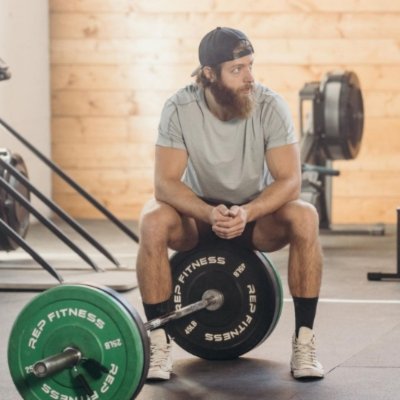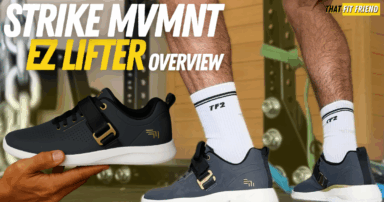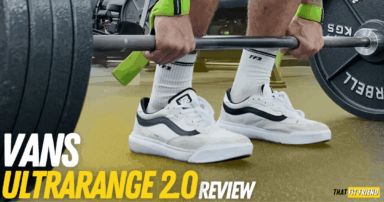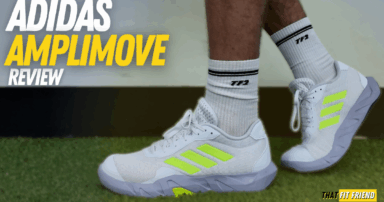As I write this guide, I’m having to continue to adjust in my seat because my glutes are so freakin’ sore from my reverse lunge day. I have a special place in my heart for the reverse lunge, honestly.
This exercise has been fantastic for not only building my legs and glutes but also helping me to work around cranky knees while still making lower-body progress. If you’ve been wanting to blow up your legs and glutes, then get to reverse lunging.
The reverse lunge can be an awesome lunge variation for lifters wanting to improve their unilateral leg strength and they can be great for loading and biasing the glutes.
How To Reverse Lunge
Step 1: Stand and Get Set
With your own body weight, dumbbells, a barbell, or other weight, start in a standing position with your feet parallel to one another. Step backward with one leg and keep the opposing foot planted.
Step 2: Step Back and Hover Or Lightly Tap Knee
The amount you step backward will vary based on your mobility and limb lengths. Generally, you want your front leg around 90ish degrees and your back leg should follow a flow that is comfortable for you.
You can shift your reverse lunge mechanics to bias different muscles slightly by shortening and lengthening your lunge stride and I’ll discuss that below in my benefits section.
Step 3: Stand Back Up and Squeeze the Glutes
As you stand back up, think about pressing the front leg’s foot down evenly into the ground with a slight bias on the lateral part of the heel, and think about keeping tension in the glutes.
A great cue I use is, “Bring your glutes through as you stand,” and this can sometimes cue more glute involvement during the concentric or standing portion of this exercise.
Why Perform Them
If you’re thinking about experimenting and using reverse lunges in your program, then it’s a good idea to familiarize yourself with some of the main benefits of performing reverse lunges.
Note, reverse lunge benefits will ebb and flow based on your goals and needs, and the following are some of my favorite benefits that I’ll language to clients when programming this lunge variation for them.
1. Awesome for Focusing On the Glutes
The first reverse lunge benefit that is worth discussing is how great they can be for biasing and focusing on the glutes. While every lunge variation will hit the glutes, generally, the reverse lunge will give you a little “more” regarding a glute focus.
When you step backward in a reverse lunge you have an awesome opportunity to lengthen the glute on the planted leg as you go into hip flexion. This lengthens the glute max and the glute medius will be at play to help stabilize the hips.
Plus, as you step back it can be a little easier to manipulate how you’re positioning the hips to “feel” the glutes a little more because you can typically control reverse lunges to a higher degree compared to a forward or lateral lunge.
In layman’s terms, it’s typically easier to find balance when doing reverse lunges which then can make it easier to manipulate your torso position, stride length, and the angle of the hips to give you more opportunities to hit the glutes more heavily.
Coaching Tip: To get a little “more” for the glutes with reverse lunges, try leaning forward a little more with the torso. This will lengthen the glute max even more. As you stand, press hard into the lateral heel and drive the glutes through.
2. Great Lunge Variation for Beginners
Another benefit of reverse lunges is that they can be a great option for beginners. If you’re brand new to lifting and you’ve never performed unilateral lower body exercises, then you’ll want to find and use progressions that allow you to sharpen these skills.
For example, most coaches including myself will start a true beginner with split squats, then progress them to other split squat variations and then lunges which are more dynamic in nature.
The reverse lunge is a lunge variation that most beginners will typically find easier to perform compared to a forward, walking, or lateral lunge. This typically has to do with the backward step and how it can easier to create a counterbalance when stepping back.
If you’re new to lunges, then starting with reverse lunges can be a great way to help you acclimate to this exercise and sharpen your abilities to create balance while managing different loads.
3. Can Be a Little Easier On the Knees
A lesser-talked-about and more nuanced reverse lunge benefit include their ability to be a little easier on the knees. I’m someone who has cranky knees (context: I get habitual runner’s knee from a quad rupture I had) here and there and when I want to target the legs and glutes but not aggravate my knees I’ll typically opt for reverse lunges.
Since this lunge variation is a little more hip-dominant as opposed to being more knee-dominant like walking and forward lunges, it can be a great option to limit stress on the knees while keeping you training hard.
In practice, when you step backward with a reverse lunge it can be a lot easier to manipulate the knee angle of your front leg, so if deep knee flexion is tough for you, then you can more easily limit how much flexion you’re working through.
This can be great because most lifters will find that they can still push their training for the quads, adductors, and glutes with reverse lunges without further aggravating cranky knees or causing a ton of pain and discomfort.
Coach’s Note: This benefit is highly contextual and you may find that reverse lunges still aggravate cranky knees. If that’s the case, then keep exploring variations that work for your needs.
Muscles Worked
The reverse lunge is awesome because it trains a lot of the lower body muscles, and it can help you improve your single-leg stability and balance. Below are some of the main muscles that the reverse lunge trains.
Mistakes to Avoid
To get more out of your reverse lunges, you’ll want to make sure you’re avoiding some of the most common mistakes lifters make when performing them. Below are two of the main mistakes I see my clients make with reverse lunges.
1. Using the Back Leg Too Much
When performing reverse lunge variations the back leg should be active, but you shouldn’t be doing a majority of the work through the back leg. In practice, this will look like a lifter that is pushing off the back leg to stand back up.
If you’re unsure if you’re doing this, video yourself from the side and watch what happens with your hips when you stand up during reps. When the hips are shifting forward a ton then that’s typically a sign that the back leg is doing too much and you’re likely driving through the toes a little too much.
The Fix: Think about using the back leg as a supportive tool versus a prime mover. Initiate through your front leg and let the back leg follow suit while driving the glutes through.
2. Rushing Through Reps
Another mistake that I’ll see lifters make with reverse lunges is rushing reps. In practice, this looks like reps that are performed really fast and that are inconsistent, and you’ll typically see a lot of knee banging when reps are rushed.
Since it can be a little easier to manipulate reverse lunges to target different muscles, it’s a good rule of thumb to perform them with a smooth tempo. This will give you more feel with this lunge variation and keep you consistent with your reps.
The Fix: Think about hovering the back knee above the ground before standing or lightly tap it on the ground. If you perform reps with this mindset then you’ll notice that you’ll naturally slow reps down.
Reverse Lunge Vs Deficit Reverse Lunge
The deficit reverse lunge is a progression from the reverse lunge, and it can be an awesome tool that gives you even more range of motion to hit the glutes with your reverse lunges.
With deficit reverse lunges, you’ll want to make sure you have two things. First, you want to ensure your reverse lunge form is on lock. Second, you want to make sure you have the mobility for the height you’re performing the reverse deficit lunge.
Far too often, I see lifters perform reverse deficit lunges from heights that don’t align with their mobility capabilities. In this context, the deficit isn’t doing much as they’re not leveraging it to its full potential due to the limitations of their mobility.
As a rule of thumb, you’ll want to perform deficit reverse lunges from a height that allows you to still back your back knee on the ground or hover it to the same height as your normal reverse lunges.
If you do this, then you’re usually on a good track to get more out of reverse deficit lunges for your glutes as you’re able to go through the degree of hip flexion needed on the planted leg when performing reps.
Below are some scenarios where different lifters may want to opt for reverse lunges versus reverse deficit lunges.
- Beginner Lifters: Start with reverse lunges.
- Intermediate Lifters: Do reverse lunges or deficit reverse lunges from a low height.
- Advanced Lifters Wanting a Maximal Glute Bias: Perform reverse deficit lunges.
- Lifter With Cranky Knees: Experiment with slow and light reverse lunges.
When in doubt, start with the basics and progress slowly. For example, there’s no reward for performing sloppy reverse lunge reps. Work within your means and progress accordingly based on your capabilities and goals.
Takeaway Thoughts
The reverse lunge is one of my favorite lunge variations for building strong and thick legs and glutes. This variation can be great for beginners and lifters from all walks of life wanting to build lower body strength.
I also like the reverse lunge because it can be a little more knee-friendly when lifters are navigating cranky and achy knees from training, sports, and life.
If you have additional questions about the reverse lunge, drop a comment below or reach out to me personally via Instagram (@jake_boly or @that_fit_friend).


















Add a Comment